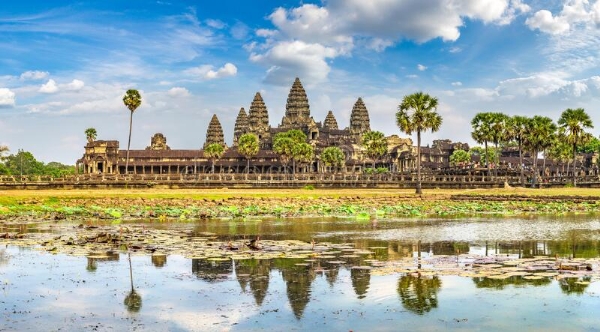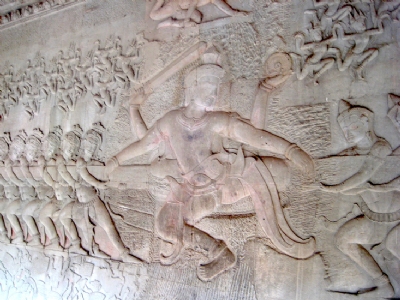Angkor Wat, the largest temple complex in the world dedicated to Vishnu
The 5 central towers of Angkor Wat symbolize peaks of Mount Meru, which according to Hindu mythology, is where the Gods dwell
Total Views |
Angkor Wat is a large temple complex located in northern Cambodia. It was originally built in the first half of the 12th century as a Hindu temple. Spread across over 400 acres, Angkor Wat is said to be the largest religious monument in the world. Its name translates to “Temple city” in Khmer language, references that it was built by Emperor Suryavarman II, who ruled the region from 1113 to 1150 as the state temple and political center of his empire.

Originally dedicated to the Hindu god Vishnu, Angkor Wat became a Buddhist temple by the end of the 12th century. The vast religious complex of Angkor Wat comprises more than 1000 buildings, and it is one of the great cultural wonders of the world. Angkor Wat is the world’s largest religious structure, covering around 400 acres (160 hectares), and marks the high point of Khmer architecture.
History | The city of Angkor was the royal centre from which a dynasty of Khmer kings ruled one of the largest, most prosperous kingdoms in the history of Southeast Asia. From the end of the 9th century until early in the 13th century, numerous construction projects were undertaken, the most notable of which was Angkor Wat. It was built by Suryavarman II as a vast funerary temple within which his remains were to be deposited. Construction is believed to have spanned across 3 decades!
The largest religious monument in the World.
— Raghu (@IndiaTales7) February 21, 2022
Angkor Wat ~ The Temple of Bhagwan Vishnu Ji, carved with Mahabharata & Ramayana epic, that Bharata once had, but India never! pic.twitter.com/wmtwJnXZDd
Architecture | All of the original religious motifs in the temple, have been derived from Hinduism. The temple was dedicated to the gods Shiva, Brahma & Vishnu. The five central towers of Angkor Wat symbolize peaks of Mount Meru, which according to Hindu mythology is where the Gods dwell. The mountain is said to be surrounded by an ocean.
Also Read | Patwon ki Haveli: the 19th century grandeur of Jaisalmer!
The temple complex’s big moat hints the oceans at the edge of the world. A 617-foot bridge allows access to the site. The temple is reached by passing through 3 galleries. The temple walls are covered with bas-relief sculptures of very high quality, representing Hindu gods and ancient Khmer scenes, as well as scenes from the Mahabharata and Ramayana.
There are 1,200 square meters of carved bas reliefs at Angkor Wat, representing eight different Hindu stories. The most important narrative represented at Angkor Wat is the Churning of the ocean of Milk, which depicts a story about the beginning of time and the creation of the universe (below).

In 15th century, Angkor was abandoned. Still, the Buddhist monks present there, maintained Angkor Wat, which remained an important pilgrimage site and continued to attract European visitors. Angkor Wat was “rediscovered” after the French colonial regime was established in 1863.
In the 20th century various restoration programs were undertaken, but they were suspended amid the political unrest that engulfed Cambodia in the 1970s. When work resumed in the mid-1980s, the required repairs were extensive. Sections did have to be rebuilt.
Also Read | Undavalli Caves, where faiths merge!
In 1992 the Angkor complex, was designated a World Heritage Sire by UNESCO, and was immediately added to the list of World Heritage in Danger. In the following years, restoration efforts increased, and Angkor was removed from the danger list in 2004. Today, Angkor Wat is one of the most important pilgrimage shrines in Southeast Asia, and is also a popular tourist attraction.
Archaeologist R. Nagaswamy talked about the cultural connections between Cambodia and India - He sent his Buddhist emissaries to Thailand and also to Cambodia, which was then a great power. But there is reason to believe that there was contact from the 1st century BCE. Chinese annals say that when Chinese travellers came to Cambodia then, they found a significant colony of Brahmins there.
The contact between South India and Cambodia was mostly through the sea. Merchants from India came to Cambodia - attested by potteries belonging to 1st century AD from India. They carried Brahmi script from India to Thailand, Cambodia and other South East Asian countries. The earliest inscriptions, from 3rd century AD are in Sanskrit in Pallava grantha.
Also Read | Ranakpur Jain temple: A masterpiece of architecture in Rajasthan
The maximum number of Sanskrit inscriptions is to be seen in Cambodia rather than here. Siva linga pratishta is seen in almost every village. In Khmer, they consecrated Ramayana & Mahabharata - and the chapters were recited daily in the temples. Bilingual inscriptions are seen in Khmer from the 6th century - in the regional language of Khmer and in Sanskrit. The regional language became classical because of contact with Sanskrit.
The earliest available structures in Cambodia resemble Gupta architecture. From the 8th century arose granite structures that resemble South Indian temples. There is evidence of the South Indian style of architecture but it had its own expression.
The architecture, sculpture, grammar, literature and lifestyles of Cambodia were controlled by the Dharmasastra. The iconography too was influenced by our culture. After 14th century, the land turned to Buddhism owing to the influence of Sri Lanka. In the 13th century, some Brahmanas went from Rameswaram to Cambodia.


